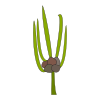Walking onions, also known as tree onions or Egyptian onions, are a fascinating and unique variety of perennial onions that stand out in the garden due to their unusual growth habits. Scientifically referred to as Allium × proliferum, they are known for their ability to "walk" across the garden.
The walking onion plant is characterised by its clusters of bulblets, or small onions, that form at the top of a long, sturdy stalk. These stalks emerge from a base that is similar to that of a traditional onion plant, featuring a bulb underground and a tuft of green leaves that resemble those of chives. As the bulblets at the top mature, their weight causes the stalk to bend toward the ground, allowing the bulblets to take root in the soil nearby. This process naturally propagates the plant, leading to new growth around the original, thus giving the impression that the onion is "walking" from one place to another.
Walking onions are also highly prized for their culinary versatility. The underground bulbs, green stalks, and aerial bulblets can all be harvested and eaten. The flavour of these onions is typically sharp and pungent, akin to shallots, making them excellent for use in a variety of dishes. They add a flavourful punch to soups, salads, stir-fries, and more.
Cultivating walking onions is straightforward and rewarding, as they are hardy and require minimal maintenance once established. They thrive in a range of soil types, although they prefer well-draining soil and a sunny location. Walking onions are also resilient to pests and diseases, making them a perfect choice for both novice and experienced gardeners looking to add something unique to their edible landscapes.
How To Grow
Growing walking onions, also known as tree onions or Egyptian onions, is a delightful venture for any gardener interested in perennial, low-maintenance plants. These unique onions "walk" through your garden by setting bulblets on their tops that eventually take root and grow into new plants. Here’s a guide on how to successfully grow walking onions in your garden:
-
Choosing a Planting Site
Sunlight: Walking onions thrive in full sun but can tolerate partial shade. Aim for a spot that receives at least six hours of direct sunlight per day.
Soil: They are not particularly fussy about soil but prefer well-drained soil rich in organic matter. A pH between 6.0 and 7.0 is ideal.
-
Preparing the Soil
Amend the Soil: Mix in compost or well-rotted manure to enrich the soil. This will help improve drainage and nutrient content.
Till the Soil: Loosen the soil to a depth of about 12 inches to allow for good root development.
-
Planting the Bulblets
When to Plant: Early spring or fall are the best times to plant walking onions. In regions with milder winters, planting can be done in the fall.
Planting Depth and Spacing: Plant the bulblets about 2 inches deep and 4 to 6 inches apart. Point the tip of the bulblet upward.
Watering: After planting, water the area well to settle the soil around the bulblets.
-
Caring for Walking Onions
Watering: Keep the soil moist, especially during dry spells. However, avoid overwatering as this can lead to bulb rot.
Mulching: Apply a layer of organic mulch such as straw or wood chips around the plants to retain moisture and suppress weeds.
Feeding: Feed your walking onions with a balanced fertilizer in early spring as new growth appears. Alternatively, side-dress with compost.
Weeding: Keep the area free of weeds, which can compete for nutrients and water.
How/When To Harvesting
Harvesting walking onions, also known as tree onions or Egyptian onions, involves several straightforward steps. These perennial plants provide multiple edible parts, including the underground bulbs, green stalks, and aerial bulblets. Here's how you can harvest each part effectively:
-
Harvesting Green Shoots
Timing: You can begin harvesting the green shoots, or leaves, of the walking onion as soon as they are long and sturdy enough to use. This can typically be done throughout the growing season.
Method: Cut the green leaves with scissors or a sharp knife, ensuring to leave at least an inch of the shoot above the ground to encourage regrowth. Harvest only a third of the leaves at a time to allow the plant to continue growing vigorously.
-
Harvesting Aerial Bulblets
Timing: The top-set bulblets are ready to harvest when they mature and the stalk begins to naturally bend towards the ground. This usually occurs in mid to late summer.
Method: Gently pick the bulblets from the top of the plant or wait until the stalks bend and touch the ground, allowing them to root naturally. You can use these bulblets for replanting or cooking.
-
Harvesting Underground Bulbs
Timing: Harvest the main underground bulbs once the tops begin to die back, which generally happens in late summer or early fall.
Method: Carefully dig around the plant with a garden fork or spade to loosen the soil. Lift the entire plant out of the ground. Remove excess soil and separate the bulbs. These bulbs can be used immediately in cooking, or they can be stored for later use.
Storage Tips
Green Shoots: Best used fresh but can be refrigerated in a plastic bag for a few days.
Bulblets: Store in a cool, dry place if you plan to replant them. For culinary use, they can be used fresh or dried.
Underground Bulbs: Cure the bulbs in a dry, ventilated area for a few days. Once dry, trim the roots and remove any loose skins. Store in a cool, dark place such as a cellar, similar to storing onions.
Harvesting walking onions not only provides fresh ingredients for your kitchen but also offers a chance to propagate new plants for your garden or to share with fellow gardeners. The process is easy, and with careful management, your walking onions can produce abundant yields year after year.


